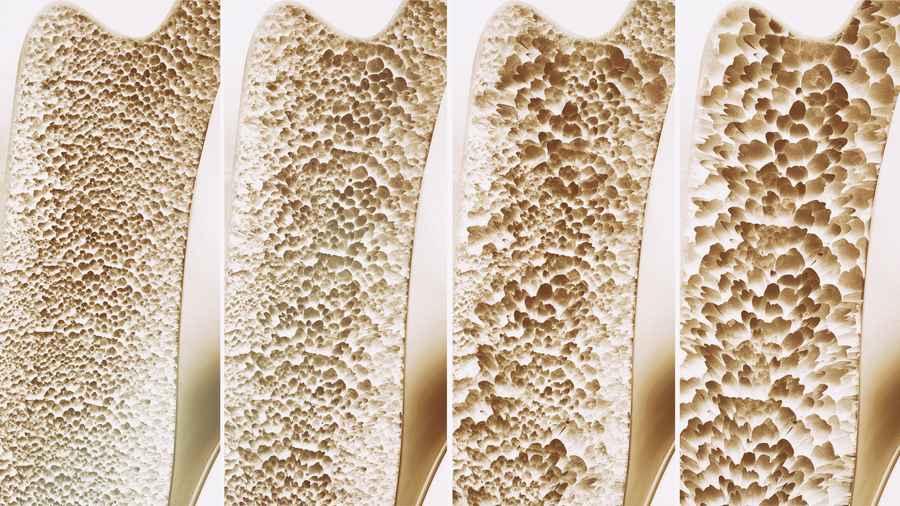What is Osteoporosis?

Osteoporosis is a condition where bones become porous or spongey and lose strength and density. This causes them to break more easily, even after a minor bump or fall. The name ‘osteoporosis’ comes from the Latin for ‘porous bones’. Bones are living tissues made up of different minerals (mainly calcium salts) that are joined together by collagen fibres. Each bone is encased in a hard shell, and this is what we see on x-rays. However, the inside of our bones look rather like honeycomb, with lots of small holes in them.
These honeycomb-like holes are perfectly healthy. But, when you have osteoporosis, the holes become bigger and bone density reduces – which is why broken bones become more likely. Osteoporosis also causes the outside of our bones to become thinner and more fragile. The pain of osteoporosis doesn’t come from bones being porous and weak, but from the fractures that the condition can result in. Any bone in the body can be affected by fractures, though they’re most common in the wrists, hips, and spine.
Who is at risk of Osteoporosis?
Anyone can get osteoporosis and, unfortunately, there are no early warning signs. However, being aware of factors that increase the risk of osteoporosis can help you to make suitable lifestyle changes to protect your bones. Some risk factors for osteoporosis that are out of our control, include…
• Gender. Women are more likely than men to develop osteoporosis. This is because the process of bone loss is accelerated after menopause when the ovaries stop producing oestrogen. Men also tend to have bigger bones, which has been found to reduce the risk of breaks.
• Age. From our late 30s our bone tissue naturally starts to decrease – though the rate at which this happens can vary from person to person. Bone tissue also loses strength with age, so regardless of how dense it is, our bones can still become more prone to breaks.
• Family history. Having a parent or sibling with osteoporosis means you’re more likely to develop it yourself – especially if either parent fractured a hip.
• A history of broken bones. According to research, you’re three times more likely to break a bone if you’ve broken one before. Other factors that can increase the chances of developing osteoporosis include…
• Low vitamin D and calcium levels. Vitamin D helps your body absorb calcium, which is an essential nutrient mineral needed for building and maintaining strong bones. So, low levels of these could increase your risk of osteoporosis and broken bones.
• Low body weight. Being underweight weakens bones for both men and women. • Gastrointestinal surgery. Stomach or intestine surgery can make it more difficult for the body to absorb essential nutrients like calcium.
• Steroids and other medications. Long-term use of corticosteroid medications can affect the bone-rebuilding process. Osteoporosis is also linked with medications used to treat seizures, gastric reflux, and cancer.
• Medical conditions. People who suffer from conditions including coeliac disease, kidney or liver disease, inflammatory bowel syndrome, cancer, or rheumatoid arthritis may be more at risk.
• Sedentary lifestyle. People who don’t do much exercise could be at a greater risk than active people. Exercises like lifting weights, running, walking and jumping are especially beneficial for maintaining bone health. • Drinking alcohol. Regularly drinking more than 14 units a week (a 125ml glass of wine is 1.5 units) affects the cells that build and break down bone. It can also make you unsteady on your feet and increase the risk of falling and breaking a bone. • Smoking. Smoking slows down the cells that build bone mass in your body and, for women, can also increase your chances of early menopause. Postmenopausal women have an increased risk of osteoporosis and breaking a bone.
Help Prevent, Manage & Improve with Osteoporosis
1. Balanced Diet: Ensure that your diet includes adequate amounts of calcium and vitamin D, as these are essential for healthy bones. Good sources of calcium include dairy products, leafy green vegetables, and fortified foods. Vitamin D can be obtained from sunlight exposure, fatty fish, and fortified foods. Consider consulting a healthcare professional or a registered dietitian for personalized dietary recommendations.
2. Regular Exercise: Engage in weight-bearing exercises and resistance training to strengthen your bones and improve bone density. Weight-bearing exercises include walking, jogging, dancing, and hiking, while resistance training involves the use of weights or resistance bands to build strength. Consult with a healthcare professional to determine the most suitable exercises for your condition.
3. Fall Prevention: Take precautions to prevent falls, as they can lead to fractures. Keep your home well-lit and free of hazards, such as loose rugs or clutter. Install handrails in stairways and grab bars in bathrooms. Consider using proper footwear with good traction and discuss any balance or mobility concerns with your healthcare provider.
4. Medications: If necessary, your healthcare provider may prescribe medications to help manage osteoporosis. These medications can help slow down bone loss or increase bone density. It is important to take these medications as directed and discuss any concerns or side effects with your healthcare provider.
5. Regular Check-ups: Stay in touch with your healthcare provider and schedule regular check-ups to monitor your bone health. They can assess your condition, provide guidance, and make any necessary adjustments to your treatment plan. Remember, it is essential to consult with a healthcare professional for personalized advice and recommendations tailored to your specific needs and medical history.
